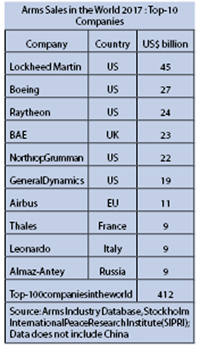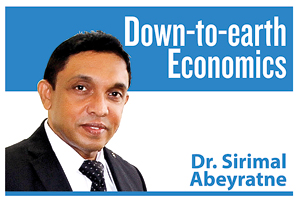Dark side of the global economy
View(s):
Armed guard outside a Colombo hotel
Sometime ago in fact it was a “government business” so that the law didn’t permit anyone else to make liquor. If anyone did, apparently it was illegal.
“Clean” activities
The point I want to get across is that GDP of any country technically represents the output value of all “clean” economic activities. There can be underground or illegal or non-licensed economic activities such as the production of swords, guns and drugs, which produce an output value. But the output value of these economic activities is not counted into GDP.
This is, however, a tricky point. Any economic activity that is considered to be “unclean”, as mentioned above, can be made “clean” by legalising them by the law or license. The government can issue a licence to somebody to produce commodities like swords, guns, drugs and liquor. Or the government can accept some of these activities under different circumstances. In such cases, the same output value that was “illegitimate” earlier is now become “legitimate” so that it can be part of GDP.
What a contrast: The measure of GDP which was penalised by a piece of law in one country can actually become inflated in another country under different circumstances.
“Laundering” the value
There is another issue. Assume that someone who is distilling and selling illicit liquor spends its illegitimate income meeting his expenses. He spends it for his family’s food and drinks, clothing, housing, utilities, transport and vacations as well as for his savings and investment.
These expenses would generate more output in all these activities through “multiplier” effects. The farmers, the manufacturers and, suppliers of the goods and services demanded by him will have to produce more of them, which increase the output value.
 As far as spending is concerned, “money” does not make a difference to its source; whether money is earned from “clean” economic activities or otherwise it is the same money, which doesn’t have a label. This means that even if it is an underground or illegal economic activity, its output value can still infiltrate into GDP through expenditure side. Finally, the money is washed and cleaned so that it can show off the economic status and progress.
As far as spending is concerned, “money” does not make a difference to its source; whether money is earned from “clean” economic activities or otherwise it is the same money, which doesn’t have a label. This means that even if it is an underground or illegal economic activity, its output value can still infiltrate into GDP through expenditure side. Finally, the money is washed and cleaned so that it can show off the economic status and progress.
Arms production
Many countries spend resources to produce arms as part of their economic activities through which they create output value; but is it a good or bad economic activity? There is no simple answer to this question. Arms are, anyway, for “destruction”, but it can also be for “protection” from destruction. Therefore, arms production in the world continues to expand as a result of an “action-reaction” process.
The world had enough experience to justify greater focus on arms production: There were three world wars, while one of them was cold and the other two hot! Then, there has been increasing terrorism threats and civil wars. All these wars and threats create demand for arms, and more and more arms.
There is no question about the complexity of the question whether arms production is good or bad, because it all depends on the “intention”.
Creating demand
Increased magnitude and intensity of violence and wars in the world, however, demands an increase in arms production as well as for its increased technological sophistication. For the same reason, there is a possibility of creating demand for arms production and its expansion to keep the economy going.
Consider two conflicting parties engaged in a war. An arms producer can supply arms to one party, and equip the other party to face them. The more they fight, the greater will be the demand for arms; the arms producer can keep up the arms production and meet the demand.
Wealth from arms
Whichever the complexities associated with the world’s arms production, legally or otherwise and, by legitimate governments and companies or illegitimate entities, it all adds up to their wealth creation, directly or indirectly.
Economics is all about wealth creation – “getting more from less”. The wealth created by any economic activity is added to the country’s total wealth, as measured by gross domestic product (GDP).
The world’s top-100 arms producing companies, excluding those of China, have supplied more than US$ 400 billion worth arms in 2017, as reported by the Stockholm International Peace Research Institute (SIPRI). While the US, Russia and the UK own 66 (two-third) of these top-10 companies, the US alone owns 47 companies.
About half of the total sales by the top-100 companies are supplied by 10 companies. Five of them are from the US, namely Lockheed Martin, Boeing, Raytheon, Northrop Grumman, and General Dynamics. Other five are from five different countries as BAE from the UK, Airbus from the EU, Thales from France, Leonardo from Italy, and Almaz-Antey from Russia.
For the two commercial aircraft manufacturers in the world – Boeing and Airbus -, arms sales is not the main business; but still these two are among the world’s top-10 arms producers too. The largest arms producer in the world – Lockheed Martin – has also been a commercial aircraft manufacturer at one time; the value of its arms sales is more than half of the total GDP of Sri Lanka.
Buyers and sellers of arms
In 2018, total exports of arms – weapons and ammunitions, excluding vehicles, ships and aircrafts – amounted to $15 billion, according to International Trade Statistics Map. About 38 per cent of that has been supplied by the US. The other large arms exporting countries are Italy, Bulgaria, Israel, South Korea, Spain, Germany, Czech Republic, Austria and Brazil.
The rich OECD countries in the world buy about half of arms exports, while the rest of the countries which are the developing countries buy the other half.
 Developing countries do not have the resources and technology to enter into sophisticated arms production, which would have forced them to buy from abroad. Nevertheless, large developing countries such as Brazil, China, and India already occupy high positions among arms-producing countries.
Developing countries do not have the resources and technology to enter into sophisticated arms production, which would have forced them to buy from abroad. Nevertheless, large developing countries such as Brazil, China, and India already occupy high positions among arms-producing countries.
Military expenditure
The governments’ military expenditure is much broader than arms production, because it includes the use of tax money by the governments to spend on military-related activities: Its capital expenditure includes government spending on arms production and imports; its current expenditure includes wage bills of the forces, transport expenses, and the maintenance costs of military structures.
The world as a whole has spent $1.8 trillion as governments’ military expenditure in 2018. According to SIPRI database, the five biggest spenders were the US, China, Saudi Arabia, India and France which together accounted for 60 per cent of global military spending. Being the largest military spender, the US alone has spent $650 billion in 2018.
Growth and employment
The building of military capabilities as well as the wars and security threats accelerate the military spending by the governments in many different countries. They create demand for arms production and sales. And arms production and sales contribute directly to GDP of the respective countries. In addition, military spending also creates aggregate demand sustaining incomes and jobs in the world.
If the world achieves peace and trust among people and nations, some countries will have to face its adverse effects through slower growth and higher unemployment. It’s an incentive to sustain conflicts and mistrust: What a world of economics! (The writer is a Professor of Economics at the University of Colombo and can be reached at sirimal@econ.cmb.ac.lk).


